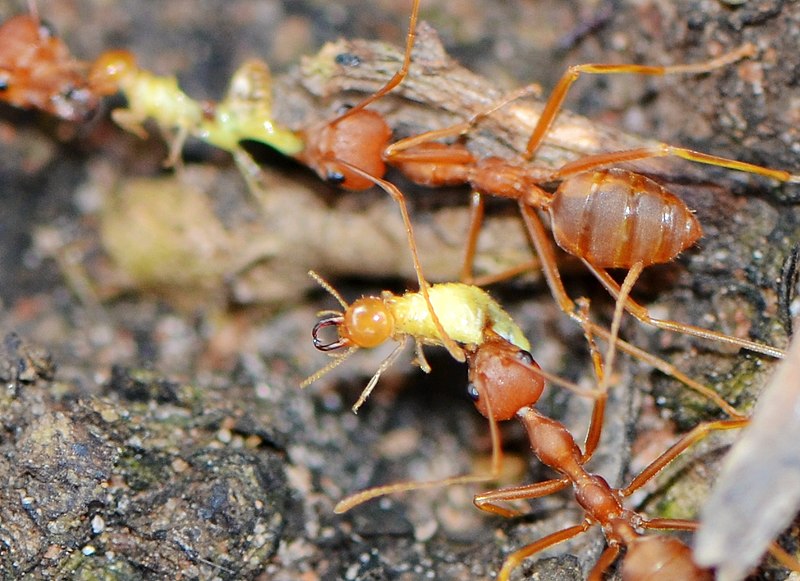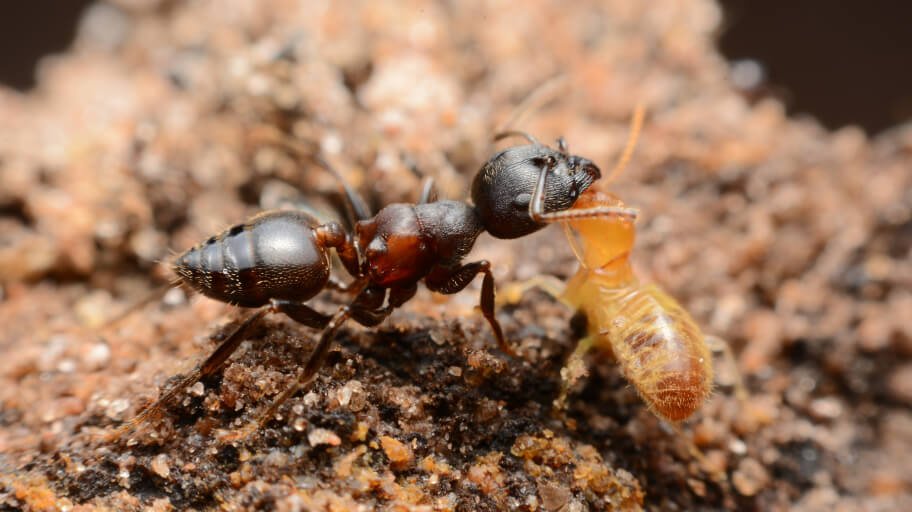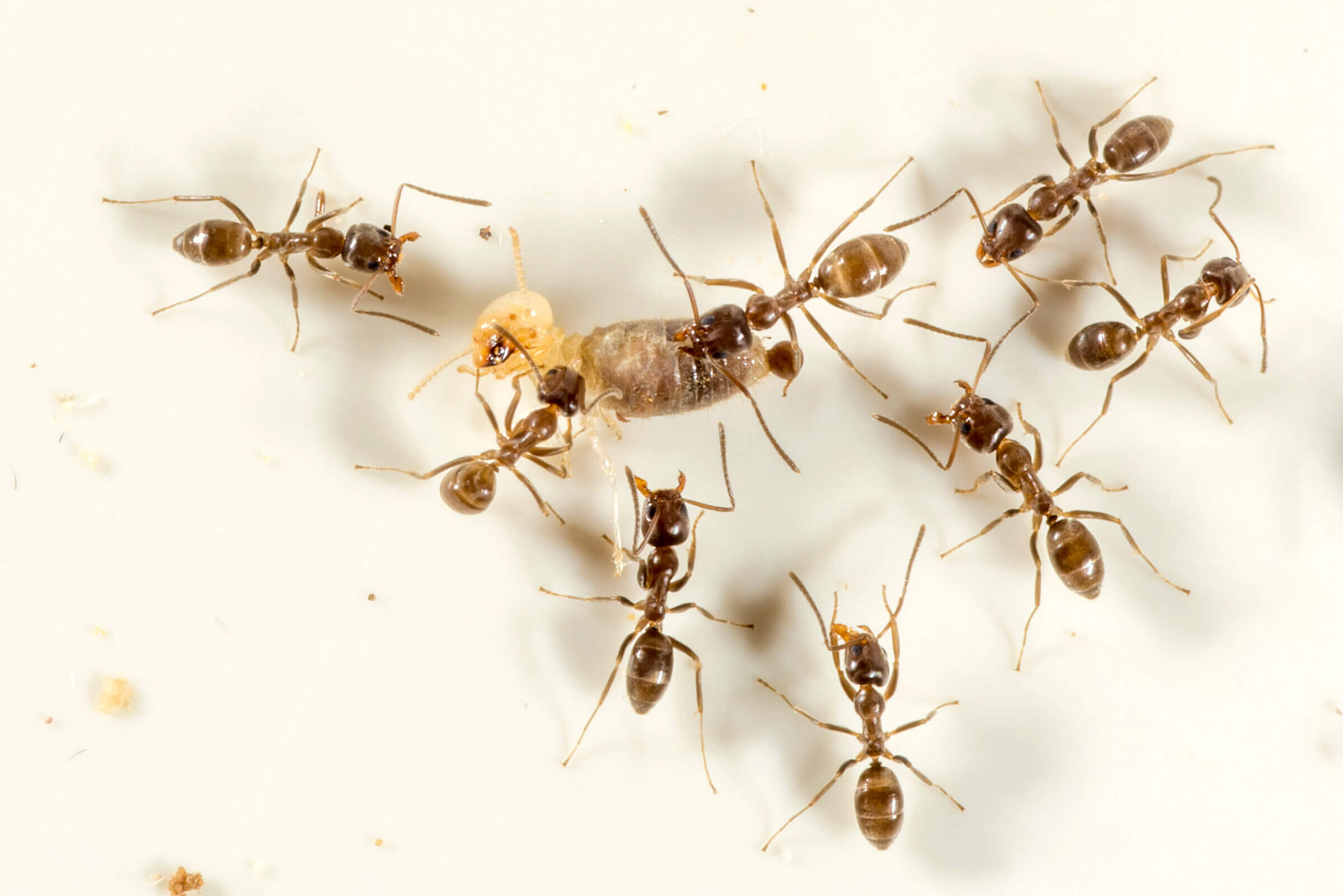Yes, ants do eat termites. Many ant species are natural predators of termites and actively hunt and consume them as a food source.
Several ant species consume termites, including:
- Pheidole: These ants are known for their large colony sizes and diverse diet, which includes termites.
- Solenopsis: Fire ants, a type of Solenopsis, are aggressive predators of termites.
- Odontomachus: Also called trap-jaw ants, they have powerful jaws to capture and eat termites.
Now, to understand why ants eat termites, let’s briefly explore the characteristics of ants and termites.
Characteristics of Ants and Termites

A. Ant Biology and Behavior: Ants are social insects living in colonies with a structured hierarchy. They are omnivores, meaning they eat various food types, including insects, nectar, and plant matter. Ants are known for their teamwork and foraging abilities.
B. Overview of Termite Biology and Behavior: Termites are also social insects living in colonies, but their hierarchy differs from ants.
Termites are herbivores, primarily feeding on cellulose-rich materials like wood. They have particular gut bacteria that help them digest cellulose, making them excellent decomposers.
C. Differences and Similarities between Ants and Termites:
Dietary Differences:
Ants: Ants do eat termites, but it depends on the ant species and the availability of termites. Some ant species have termites as a part of their diet, while others prefer other food sources.
Termites: Termites do not typically eat ants. They are more interested in cellulose-rich materials, like wood, soil, and plant debris.
Foraging Behavior:
Ants: Ants are known for their active foraging behavior. They hunt for various food sources, including termites, and return them to their colonies.
Termites: Termites usually stay close to their nests and feed on nearby cellulose sources. They don’t actively hunt ants or other insects.
Conclusion: In summary, ants do eat termites, but it depends on the specific ant species and their dietary preferences.
Termites, on the other hand, primarily feed on cellulose-rich materials and do not actively hunt ants. So, while ants can consume termites, it’s not a universal behavior among all ant species.
The Eating Habits of Ants
A. Types of Food Ants Consume: Ants are opportunistic feeders, consuming a variety of foods. Their diet can include:
Insects: Ants frequently hunt and eat insects, such as termites, flies, and caterpillars.
Nectar: Ants are known to collect nectar from flowers, which serves as a source of carbohydrates.
Honeydew: Some ant species maintain a mutualistic relationship with aphids, feeding on the sugary substance called honeydew that aphids produce.
Fruits: Ants may feed on ripe fruits, especially those fallen on the ground.
Seeds: Certain ant species gather and store seeds in their nests.
Fungi: Some ants cultivate fungi in their colonies, which they consume as a food source.
B. Nutritional Requirements of Ants: Ants have specific nutritional needs to maintain their colonies. These include:
Proteins: Ants require proteins for growth and reproduction. Insects and other small arthropods provide essential protein.
Carbohydrates: Carbohydrates from nectar, honeydew, and fruits supply energy for ants.
Lipids: While less emphasized, lipids from certain food sources contribute to their diet.
Vitamins and Minerals: Ants obtain necessary vitamins and minerals from diverse food sources.
C. Ants as Predators and Scavengers: Ants exhibit a dual role as predators and scavengers, which can vary based on the ant species. Here are some numerical insights:
- Approximately 30% of an ant colony’s diet consists of insects they actively hunt.
- Ants spend about 20% of their foraging time gathering nectar.
- Another 20% of their foraging time may be dedicated to collecting honeydew from aphids.
- The remaining 30% comprises other food items like seeds, fruits, and fungi.
In conclusion, ants have a diverse diet that includes insects like termites, among other food sources. They get all the nutrients they need from a well-rounded diet that includes proteins, carbs, fats, vitamins, and minerals.
Ants play the roles of both predators and scavengers, with specific percentages of their diet dedicated to various food types.
The Diet of Termites
A. Types of Food Termites Consume: Termites are primarily herbivores, and their diet consists of:
Wood: Termites are well-known for consuming wood, particularly dead and decaying trees. This is their primary food source.
Plant Material: Besides wood, termites can feed on various plant materials, including leaves, grasses, and roots.
Decomposed Organic Matter: Termites are detritivores that feed on decomposed organic matter found in soil or rotting wood.
Fungi: Some termite species have a mutualistic relationship with fungi, which they cultivate and consume.
Algae: Certain termites consume algae found in their nests or on damp surfaces.
B. Nutritional Requirements of Termites: Termites have specific nutritional needs, primarily driven by their cellulose-rich diet:
Cellulose: Wood and plants are mostly made of cellulose, and it’s the main energy source for termites.
Microorganisms: Termites have a symbiotic relationship with microorganisms in their gut that help digest cellulose. These microorganisms provide essential nutrients.
Proteins: Termites obtain proteins from consuming fungi, decaying plant material, or other insects they may encounter.
C. Termites as Cellulose Digesters: Termites are unique among insects for their ability to digest cellulose efficiently. Here are some numerical insights:
- Termites can break down cellulose in their stomachs thanks to tiny organisms living there.
- These microorganisms can make up as much as 60% of a termite’s body weight.
- Termites can convert cellulose into energy, allowing them to thrive on a diet that is difficult for many other organisms to utilize.
Ants vs. Termites: Can Ants Eat Termites?
A. Ant and Termite Interactions in Nature: In nature, ants and termites often share ecosystems, and their interactions can vary. Some key observations include:
Predatory Behavior: Many ant species are opportunistic predators and can hunt termites when they come across them.
Competitive Coexistence: Ants and termites may compete for resources like food and shelter. This competition can influence their interactions.
B. Examining Scientific Studies and Observations: Scientific studies and observations have shed light on whether ants eat termites:
Research Findings: Studies have documented ants preying on termites, providing evidence that some ant species eat termites.
Species-Specific Behavior: Ant species vary in dietary preferences, so not all ants consume termites.
C. Discussing Factors That Influence Ant Predation on Termites:
Several factors can influence whether ants eat termites:
Ant Species: Some ant species have evolved to specialize in termite predation. Examples include army ants and driver ants, which are highly effective termite hunters.
Availability: The presence and abundance of termites in an area influence whether ants encounter them and decide to eat them.
Colony Needs: Ant colonies may prioritize certain food sources based on their colony’s nutritional requirements. This can affect their willingness to hunt termites.
Territorial Behavior: Ants are territorial, and their territory may determine the frequency of termite encounters.
Conclusion: In conclusion, yes, ants can eat termites, and this interaction depends on various factors, including ant species, termite availability, colony needs, and territorial behavior.
While some ants are efficient termite predators, not all ant species exhibit this behavior. Therefore, whether ants eat termites in a specific ecosystem can vary based on these factors.
The Role of Termites in Ant Colonies

A. Mutualistic Relationships Between Ants and Termites:
Symbiotic Bonds: Ants and termites have developed mutually beneficial relationships in certain ecosystems. These relationships are called mutualisms.
Termite Nesting Sites: Some ant species use abandoned termite nests as their own nesting sites. This provides the ants with a well-protected and readily available habitat.
Termite Prey: Certain ant species feed on termites, utilizing them as a food source.
B. How Ants Benefit from Termites in Certain Ecosystems:
Shelter and Nesting Sites: Ants often occupy termite nests that are no longer in use. These nests offer protection from predators and harsh environmental conditions, reducing the ants’ vulnerability.
Resource Sharing: In some mutualistic relationships, ants and termites share resources. Ants may feed on the fungi that termites cultivate within their nests, benefiting from the nutrient-rich fungus.
Predatory Behavior: Ants may hunt termites when the opportunity arises. This predatory behavior can supplement the ants’ diet, especially when other food sources are scarce.
C. The Significance of Termite Prey to Ant Colonies:
Dietary Diversity: Including termites in their diet adds diversity to the ants’ nutrition. This diversity can be essential for ant colonies’ overall health and productivity.
Energy Source: Termites are rich in protein, providing ants with a valuable energy source. This can be particularly important during certain stages of the ant colony’s life cycle, such as when raising young ants.
Reduced Competition: When ants hunt termites, they might have less competition for things like food and places to live in their environment. This can make ants more successful.
Conclusion:
In certain ecosystems, termites play a significant role in the lives of ants. The mutualistic relationships between ants and termites benefit both parties, with termites providing shelter, resources, and a source of nutrition for ants.
This relationship illustrates the intricate web of interactions that exists in nature, allowing different species to thrive together.
FAQs
What types of ants eat termites?
Ants from various genera, such as Pheidole, Solenopsis, and Odontomachus, are among those that commonly consume termites.
Are ants’ natural predators of termites?
Yes, ants are natural predators of termites and play a significant role in termite population control.
How do ants capture termites?
Ants often use their strong mandibles (jaws) to capture termites, and some species may also release pheromones to recruit other ants for help.
Do ants only eat live termites, or do they consume dead ones, too?
Depending on the ant species and circumstances, ants may consume both live and dead termites.
Do ants eat the entire termite, including the wings and body?
Yes, ants often consume the entire termite, including the wings and body.
Do ants raid termite colonies for food?
Yes, certain ant species do raid termite colonies for food.
Are there any ant species that have a specialized diet of termites?
Yes, some ant species have a specialized diet that includes termites.
Do ants actively hunt termites in homes or structures?
Yes, some ant species actively hunt termites in homes or structures.
Can ants help in controlling termite infestations?
Yes, ants can help in controlling termite infestations by preying on termites and disrupting their colonies.
Conclusion
In conclusion, ants are known to eat termites. However, the relationship between ants and termites goes beyond predation.
While some ants are predators of termites, certain termite species have developed specialized defensive mechanisms to ward off any types of ant’s attacks.
These interactions highlight the complexity and diversity of nature and emphasize the intricate nature of predator-prey relationships in the animal kingdom.

